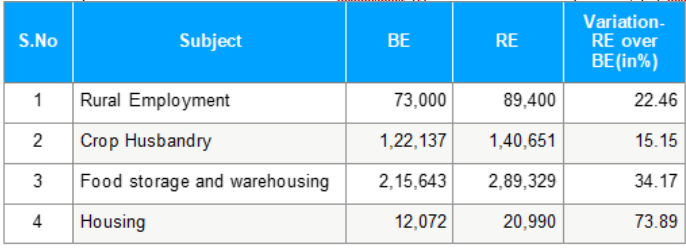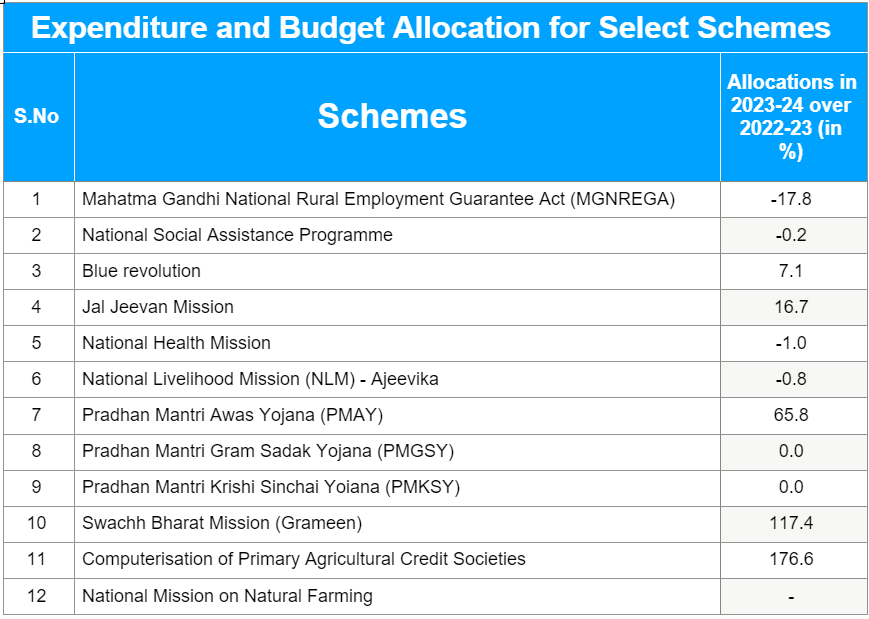ForumIAS announcing GS Foundation Program for UPSC CSE 2025-26 from 19 April. Click Here for more information.
Contents
- 1 Introduction
- 2 Development directions in Budget – Refocusing Priority Areas
- 3 An overall review of Development Directions in Budget
- 4 Development Directions in Budget – Rural Employment Programmes
- 5 Livelihoods and Employment through Agri- development
- 6 Development Directions in Budget – Digital Infrastructure Push
- 7 Development Directions in Budget – Encouraging Nutri-Cereals
- 8 Development Directions in Budget – Reposing Faith in Cooperatives
- 9 Conclusion
| For 7PM Editorial Archives click HERE → |
Introduction
The Economic Survey 2022-23 gave a positive outlook for India’s economic growth in FY 2023-24, citing the country’s resilience in the post-COVID era. The survey emphasised the importance of agriculture and rural development for the growth of everyone.
Over the past six years, the agriculture sector has shown steady growth. In the Union Budget 2023-24, the Indian government has given top priority to a number of areas related to agriculture, rural jobs, and rural ways of making a living.
This article attempts to explain the inbuilt policy direction and socioeconomic intent of the Government by discussing a few agriculture and rural livelihood and employment-related focus areas as prioritised in the Budget 2023-24.
Development directions in Budget – Refocusing Priority Areas

The Budget speech emphasised seven priority areas and underscored the Union Government’s intentions to achieve goals linked to the prioritised domain. Ensuring complementarity, the Budget has outlined to achieve (i) inclusive development; (ii) connecting targeted clients and reaching the last mile; (iii) boosting infrastructure and investment; (iv) bringing in innovation, technology for unleashing the latent productive potential; (v) meeting climate change effects by developing and focusing green growth-led strategic action; (vi) identifying and consolidating the power of youth and enhancing their participation in the economic growth; and (vii) strengthening financial sector for effective financial inclusion.
The Budget announcements have emphasised on making agriculture future ready and inclusive while envisioning youth participation and encouraging rural employment and income growth.
An overall review of Development Directions in Budget

A review of the Revised Estimates (RE) and Budget Expenditure (BE) of 2022-23 indicates that rural employment initiatives, crop husbandry, including farming and the raising of livestock, poultry and other activities, food storage and warehousing and housing got higher allocations.
These increased resource allocations aimed at stimulating economic growth along with job creation, income and wealth generation and enhancement of overall consumption demand in rural India.
Rural areas and the agriculture sector are seen as important for growth, with investments planned for job creation and development in these areas. Rural development saw a decrease in allocation. This suggests the potential to allocate resources to other emerging sectors.
The budget allocation for rural housing, fishery activities, and water and sanitation has increased in 2023-24 compared to 2022-23. A new sub-scheme of Pradhan Mantri Matsya Sampada Yojana aims to improve value chain efficiencies in the fishery sector and expand its market.
Additionally, a new Scheme, National Mission on Natural Farming, with Rs. 459 crore budget allocation has been launched to promote natural and organic farming practices and reduce dependency on chemical-based fertilizers.
Development Directions in Budget – Rural Employment Programmes
- The Union Budget 2023-24 has allocated Rs. 60,000 crores to MGNREGA and Rs. 14,129 crores to National Rural Livelihood Mission (NLM) to generate wage and self-employment opportunities in rural areas. However, the allocation to both schemes has reduced from the previous year.
- To make the implementation effective, the planning process at the Village Panchayat level needs to be reviewed and revived, and a professional cadre of quality experts needs to be raised at the community level to guide the outcome-based public works planning and monitoring.
- The focus on utilising MGNREGA funds for fodder production and implementing notified activities would help the livestock sector and enhance farm income.
- NLM has two important self-employment schematic interventions viz. Deen Dayal Upadhyaya Grameen Kaushal Yojana (DDU-GKY) and Deendayal Antyodaya Yojana – National Rural Livelihood Mission (DAY-NRLM).
- The Budget has announced the revamping of the credit guarantee scheme for Micro, Small, Medium enterprises (MSMEs).
- The village entrepreneurship development approach of DAY-NRLM is aimed at creating a catalytic local entrepreneurial ecosystem and improving rural livelihoods and income by converging rural development efforts with agri-infrastructure.
- The new and innovative rural enterprises scheduled to be established and facilitated under NLM during 23-24 will assure financial inclusion, increase household income, and facilitate farm logistics at the community level.
| Read more: National Livestock Mission (NLM) |
Livelihoods and Employment through Agri- development
A number of measures have been suggested in the budget to increase production, productivity, farm and non-farm profits and farmers’ income. In order to achieve the expected goals of the government, there is need to ensure active participatory actions towards (a) reducing water stress by comprehensive water planning; (b) promoting natural and organic farming practices (c) ensuring balanced use of fertilisers; (d) strengthening operation green initiatives though promotion and nurturing of Farmer Producer Organisations (FPOs), cooperatives and other rural collectives in agriculture, dairy and fisheries; (e) establishing and enhancing agri-logistic facilities like agri-warehousing, cold storage, reefer vans; (f) mapping and geo-tagging existing agri-logistics and ensuring viability funding for setting up such infrastructure at taluka level through public-private partnerships; (g) enhancing holding capacity and reducing logistic costs of farmers through construction and operation of community-led village storages; (h) connecting unconnected areas, building and sustaining a national cold supply chain; (i) integrating -negotiable warehousing receipts with e-NAM; (j) developing fodder farms through Mahatma Gandhi National Rural Employment Guarantee Act (MGNREGA); (k) developing, promoting and making profitable fisheries sector through collectivised effort; (l) doubling milk processing capacity by ensuring creation of primary dairy cooperatives in each panchayat/village; and (m) successfully utilising enhanced farm credit target of Rs. 20 lakh cr.
Development Directions in Budget – Digital Infrastructure Push
- The Budget 23-24 has prioritised building the digital infrastructure for agriculture as an open source and interoperable public good to improve access to relevant and timely information services for crop planning, crop health, and agri-development.
- This initiative aims to incentivize banks and financial institutions to roll out end-to-end digital solutions and attract educated and unemployed local youth to provide agri-services. Additionally, an agriculture accelerator fund will encourage agri start-ups and the provision of affordable and location-specific solutions to the problems faced by farmers.
- The cluster-based and value-chain approach through Public Private Partnership is planned to enhance the productivity of cotton crops and increase the income of cotton growers.
- The Aatma Nirbhar Horticulture Clean Plant Program aims to boost the availability of disease-free, quality planting material for high-value horticulture crops.
Development Directions in Budget – Encouraging Nutri-Cereals
- The Budget 2023-24 focuses on promoting millets as a superfood, acknowledging their nutritional benefits and potential to improve the welfare of small and marginal farmers.
- The UN’s announcement of 2023 as the International Year of Millets is also highlighted as an opportunity to drive this promotion.
- The Budget aims to make India a global hub for millets by supporting best practices, research, and technologies, and encouraging the integration of biodiversity, agroecology, nutrition, and health.
- To achieve this, the Budget proposes immediate actions to identify, preserve, and multiply quality millet seeds through community seed cooperatives, create specialized seed cooperatives at the village level, and set up small-scale seed processing and distribution units.
Development Directions in Budget – Reposing Faith in Cooperatives
- The Budget aims to create grain storage facilities in every panchayat through Primary Agricultural Credit Societies (PACS) to provide storage and warehouse services to farmers at an affordable cost, helping them avoid distress sales and realise better prices.
- It also aims to promote village-level community-led economic growth by facilitating the creation of multi-purpose cooperative societies, primary fisheries and dairy cooperatives in uncovered panchayats/villages in the next five years.
- The Ministry of Cooperation is taking various initiatives, such as computerisation of PACS, creating a national cooperative database and promoting multi-purpose cooperatives.
- The registration of new multi-state cooperatives in the areas of quality seed production, organic farming and exports is expected to address issues of availability of quality seeds and promote natural and organic farming practices.
- The government is promoting and nurturing new cooperatives in underdeveloped areas by offering special concessions and exemptions such as a lower tax rate for new manufacturing cooperatives and increasing applicable limits for tax deduction at source on annual cash withdrawals, amongst others.
| Read more: What are Primary Agricultural Credit Societies? |
Conclusion
The 7-point priority agenda of the Budget was the need of the hour to ensure a self-reliant, prosperous and US $5 trillion economy.
The Budget 23-24 aims to make agriculture smart, modern, future-ready, and inclusive by focusing on rural employment, agri-infrastructure, and community-led cooperative development. The government aims to increase employment and income in rural areas through wage employment and self-employment schemes and encourage rural entrepreneurship.
The initiatives aim to re-orient the rural economy by ensuring innovative and participatory investment opportunities through public, private, and community participation. The real challenge is to converge development efforts and create an enabling ecosystem for rural/farm enterprises and start-ups to ensure sustainable livelihoods and gainful employment avenues in rural areas.




